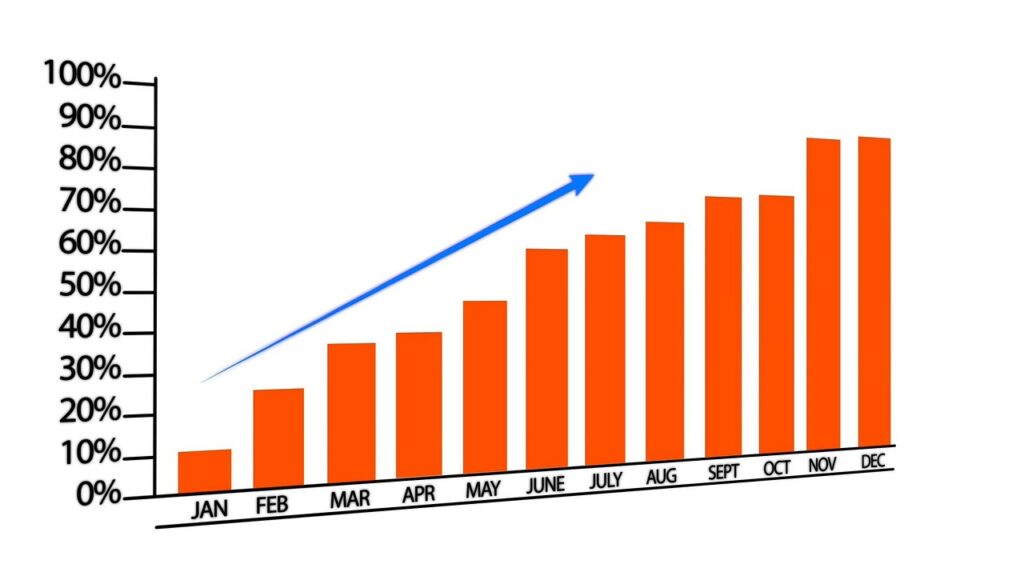What is the Definition of Franchise Business Growth? Types, Stages, Strategies & Examples
Franchise business growth can be an exhilarating experience that can skyrocket your success. But what exactly does it entail? In the context of the definition of business growth, how can you navigate the different types of growth and stages of business development? In this blog post, we’ll explore the ins and outs of franchise business growth, its strategies, and how small and medium-sized businesses can benefit from it. So, buckle up and get ready for an exciting journey!
Grow your franchise business to success with an understanding of Franchise Business Growth Types, Stages and Strategies.
Unlock limitless possibilities for success by exploring Organic & Inorganic growth strategies.
Measure progress, set goals and create a successful plan to reach the peak of success!
Understanding Franchise Business Growth: A Comprehensive Definition

Franchise business growth involves diverse strategies including opening new franchise locations, launching new products or services, and penetrating new markets. This growth isn’t just about increasing the physical presence; it also means increasing the count of franchise units, broadening the product or service range, and enhancing brand recognition. Such growth serves as a vital indication of a company’s success, drawing investment and skilled professionals.
Whether you’re experiencing expansion, scaling, development, upsizing, or enlargement, each type of growth offers thrilling opportunities and challenges. Understanding the significance of growth and prioritizing your expansion goals and strategies is key to succeeding in your defining business growth endeavors. By exploring the various types of business growth, franchise businesses that achieve growth become growth-driven companies that facilitate growth and gain market share. Are you ready to join their ranks?
Franchise Business Growth Types: Organic vs. Inorganic

Organic and inorganic growth are two exciting types of franchise business growth. Both strategies can be effective in helping franchises grow. While organic growth focuses on leveraging internal resources like new products and process optimization, inorganic growth relies on external expansion methods such as acquisitions and opening new franchise locations.
We’ll delve deeper into these two growth types to understand their pros and cons.
Organic Growth
Organic growth is an exciting and rewarding process that involves visible and tangible expansion, such as introducing new products or services and opening new business storefronts. By embracing organic growth strategies, you can maximize your resources without a large financial investment, making it a sustainable approach for expanding your franchise business and achieving sustainable results.
The implementation of an organic growth strategy can pave the way for long-term success and sustainability of your franchise business. Some essential components of organic growth include:
Introducing new product offerings
Reallocating resources
Investing in new technologies
Optimizing processes
These strategies can help your business reach new heights by catering to the needs of existing clients and attracting new ones.
Bear in mind, while organic growth might be slower than inorganic, it allows you to retain control over your business.
Inorganic Growth
In contrast, inorganic growth involves external expansion methods like mergers, acquisitions, and opening new franchise locations, which can lead to rapid growth in a franchise business. Acquisitions can significantly expand market share and enhance a company’s earnings. It’s like a high-speed train, propelling your business into new territories and markets.
Partnerships, mergers, or acquisitions can facilitate inorganic growth in franchise businesses, opening up exciting growth opportunities. Companies like Apple, Microsoft, and Amazon have successfully navigated the inorganic growth landscape and reaped its rewards. While this growth type can be faster, it also carries higher risks and requires careful planning and execution.
Stages of Franchise Business Growth: From Startup to Maturity

As your franchise business grows, it will pass through different stages, each with its unique challenges and opportunities. These stages are:
Startup
Growth
Maturity
Renewal or decline
The business lifecycle model, a crucial aspect of a successful business model, can provide valuable insights into these stages, better preparing you for the journey ahead.
We’ll delve into each stage and the intriguing challenges they bring along.
Startup Stage
The startup stage is the thrilling beginning of a franchise business when the idea is implemented, and capital is raised. It’s like the birth of a new star, full of energy and potential. Uncovering new customers and ensuring business viability during this stage is essential for future growth.
During the startup stage, ensuring your business’s viability hinges on key factors such as:
product or service development
process building
creating a brand positioning strategy
devising a marketing plan
acquiring new customers
It’s the foundation upon which your franchise empire will be built, so make sure it’s rock solid.
Growth Stage
The growth stage is an exciting phase marked by the rapidly increasing customer base and the need for scaling your franchise business. It’s like a rocket taking off, propelling your business to new heights. The challenge during this stage is to maintain brand consistency and quality while expanding your franchise locations.
A meticulously planned strategy is vital for cost-effective business scaling. Companies like McDonald’s have mastered the art of balancing growth with quality and consistency, making them a beacon of success in the franchise world.
By embracing the challenges of the growth stage, you can elevate your franchise business to new heights.
Maturity Stage
The maturity stage is characterized by:
Steady growth
Consolidation of systems
Diversification of products
Widespread recognition across different geographical areas
It’s like a tree that has reached its full height and now focuses on spreading its branches and bearing fruit.
Maintaining strong market share and profitability during the maturity stage requires prioritizing product innovation, cost control, and marketing strategies. Companies like Apple have excelled in the maturity stage by continuing to innovate and adapt to consumer trends. Embrace the challenges of the maturity stage, and your franchise business will continue to thrive.
Renewal or Decline Stage
The renewal or decline stage is a crossroads where a business can either experience a renewal or a decline in performance. It follows the maturity stage and presents an exciting opportunity to revitalize the business, much like a phoenix rising from the ashes.
Investing in digital transformation, staying ahead of changing market needs, and revitalizing your brand can give your business a new lease of life. Companies like General Electric (GE) have successfully navigated the renewal stage and emerged stronger and more resilient.
Fear not the change; instead, embrace it to overcome the challenges of the renewal or decline stage.
Implementing Effective Franchise Business Growth Strategies

Having explored the types and stages of franchise business growth, let’s now delve into the specific strategies that can facilitate your business’s forward momentum.
Ansoff’s corporate strategy mix defines four main growth strategies:
Product development
Market development
Diversification
Market penetration
Each of these growth strategy options can play a crucial role in achieving your business growth goals, making business growth important.
Product Development
Product development involves:
Creating new products or services for existing franchise locations
Leveraging your existing customer base and brand recognition
Adding more items to your menu to entice customers to keep coming back and try new offerings.
Apple is a prime example of a company that has successfully implemented a product development strategy, consistently releasing new and improved versions of their products to meet customers’ evolving needs. By focusing on product development, you can tap into the potential of your existing customer base and expand your product line effectively.
Market Development
Market development focuses on expanding your franchise business into new markets or customer segments, increasing your overall customer base. It’s like casting a wider net to catch more fish. By targeting new markets and customer segments, you can grow your business beyond its current boundaries.
Airbnb is a great example of a company that has successfully implemented a market development strategy, expanding its services to new markets around the globe. By embracing market development, you can grow your franchise business and reach new heights of success.
Diversification
Diversification is a high-risk, high-reward strategy that involves entering new markets or industries, reducing dependence on a single market or product line. It’s like exploring uncharted territory, where the potential rewards can be immense, but so are the risks.
General Electric (GE) is an exemplary example of a company that has successfully implemented a diversification strategy, expanding its product and service offerings across various industries. If you’re willing to take the plunge and diversify, your franchise business can benefit from new opportunities and reduced dependence on a single market.
Market Penetration
Market penetration aims to increase market share with existing products and services through price discounts, marketing investments, or improving franchisee support. It’s like turning up the volume on your existing success to reach even more customers.
McDonald’s is a prime example of a company that has achieved great success through market penetration, becoming a dominant player in the fast-food industry. By focusing on market penetration, you can increase your market share and further expand your franchise business.
Measuring and Maintaining Franchise Business Growth

Evaluating growth is crucial to discern whether a business is progressing. It’s like checking the scoreboard during a game to see if you’re winning. Tracking key performance indicators can help you gauge the success of your business growth. Some key performance indicators to consider are:
Gross sales
Franchisee profit
Return on investment (ROI)
Customer satisfaction
By tracking these metrics, you can get a clear picture of how your business is growing and make informed decisions to drive further success.
To maintain growth, it’s imperative to set goals and consistently enhance processes and systems. Implementing new technologies, streamlining processes, and training employees are all strategies that can help you continuously improve your franchise business and drive success.
Stay vigilant, measure your growth, and keep striving for improvement to ensure your franchise business’s continued success.
The Importance of Franchise Business Growth for Small and Medium-sized Businesses

Franchise business growth is particularly important for small and medium-sized businesses. These businesses can benefit from:
Increased profitability
Employee onboarding
Product line expansion
A competitive edge
Market share
A strong brand reputation
Embracing franchise growth helps small businesses reach their full potential and compete with larger players in the market.
Consistently seeking growth opportunities can also help a growing business maintain a competitive edge and adapt to changing market conditions. Broadening your product line or service can boost business profits and give you an advantage over competitors. Don’t let your size hold you back; embrace franchise business growth and watch your small or medium-sized business flourish.
Creating a Successful Franchise Business Growth Plan

A successful franchise business growth plan includes:
Expansion opportunities
Fiscal growth objectives
Specific marketing strategies
Employee scheduling requirements
It’s a comprehensive plan that incorporates business strategies, models, and goals, focusing on scalability and adaptability to ensure long-term success.
Quarterly evaluation of growth goals allows you to identify which objectives have been met and those that still demand your attention. Investing in digital transformation, staying ahead of changing market needs, and revitalizing your brand can help your business stay competitive and profitable.
A well-crafted growth plan is the key to unlocking the true potential of your franchise business.
Real-life Examples of Franchise Business Growth

Let’s consider some inspiring instances of franchise business growth. McDonald’s has grown its global presence using the franchise model, becoming a household name across the world. Cruise Planners and Planet Fitness are franchises in high-growth sectors that showcase the power of franchise growth.
These examples demonstrate how various growth strategies can impact the success of franchise businesses. Some of these strategies include:
Product development
Market development
Diversification
Market penetration
With the right strategies and a well-executed plan, your franchise business can follow in the footsteps of these successful franchises.
Summary
Franchise business growth is an exciting and rewarding journey that can propel your business to new heights. By understanding the different types of growth, navigating the stages of business development, and implementing effective growth strategies, you can maximize your franchise’s success. Remember to measure and maintain your growth, adapt to the ever-changing business landscape, and create a solid growth plan to ensure your franchise business thrives. The sky’s the limit!
Frequently Asked Questions
What are the 4 stages of business growth?
The four stages of business growth are startup, growth, maturity and renewal or decline. As a business evolves, it can go through additional stages such as shake-up or market introduction. Understanding each stage is essential to optimizing your business for success.
How do you measure business growth?
Measuring growth involves looking at key metrics such as conversion rate, ROI, LTV, customer retention and churn KPIs, CAC, ROAS, the percentage of revenue from new and existing customers, website traffic, revenues, profits, sales and customer numbers. The company growth rate formula is a useful tool for quantifying these metrics.
What is an example of business growth?
Growth can be achieved by diversifying to different markets, creating new products or services and making changes to the way your business operates. These are all great strategies that can help your business expand and succeed.
What is the difference between organic and inorganic growth?
Organic growth emphasizes internal resources, while inorganic growth focuses on external expansion through mergers and acquisitions.


